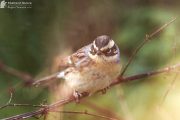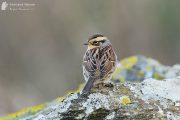Fetlar’s Siberian Accentor finders account
Posted by Brydon Thomason on Tuesday 8th November 2016 | Birding in Shetland
Brydon Thomason, Micky Maher & Stef McElwee
1) Taken from the yard it ended up and looking out over the field we found it in, showing the ditch it came out of and the area to left where it foraged around in marshy area of rank grass. 2) The all important and only image we got of ours and; 3) the very obliging Lund Siberian Accentor, which stayed another two days longer than ours.
“Just wait till our one on Fetlar- maybe Weds/Thursday??” These were BHT’s exact words in an email to MAM on the evening of 23rd October about the Lund Siberian Accentor. Both had been genuinely thrilled for Dave Cooper for such a superb and well deserved find and had enjoyed a good old bit of congratulatory banter with him. As it was on Unst however there was the inevitable, all be it fleeting thoughts of ‘if only’ and that their chance to cash in on the Accentor extravaganza had been missed.
Fast forward to 26th when BHT and MAM teamed up with SJM, for a day’s birding on Fetlar. On the ferry over there was at least some effort made to manage our expectations to a realistic level. Ten minutes on the island however, having started at South Dale, off-the-wall predictions from the far east were already flying out thick and fast.
As we approached the main croft and yard of South Dale, SJM enthusiastically hit us with “Lads, do you know the one ‘Sibe’ we haven’t actually mentioned today but should be thinking? Siberian Accentor!” To which BHT replied “You know what, after seeing the Lund bird I actually had a feeling for that very species at the very croft we are approaching, thinking Fetlar could easily have one and that’s where it could be”!
As we laughed it off two buntings rose from the roadside verge and flew a short way into an ungrazed field. One landed on the fence, clearly a Reed but the second bird had not been seen, having landed in the rank grasses. We detoured into and across the field- alas a second Reed rose from cover and landed on the fence. We continued through the small field, following a shallow ditch towards the intended cover of the yard where nettles, reed canary grass and dockings awaited…
Seconds later and barely three or four minutes after the ‘Sibe Acc’ banter, from our feet rose a small passerine that was bizarrely familiar to us. It landed in the grass no more than 20 metres away but due to length of grass, we could see no more than its head- baring the crippling crown streaks and ear coverts of a species that this October has become so very familiar to us and fellow birders and rarity hunters all over Europe. It was a brief and tantalising view before it scurried out of sight between tussocks of grass- this was it, mega time- we were most definitely in!!!
We attempted to counsel each other as we stalked cautiously to one side in order to get a better view- and there it was, creeping around between tussocks of grass, in the middle of a random marshy field- a SIBERIAN ACCENTOR!! It was a surreal and overwhelmingly knee trembling moment as the three of us stood side by side totally stunned, almost in disbelief that there right in front of us in the field we had just walked through because of two Reed Buntings- was ‘our’ very own Sibe Acc!!!
The immediate expletives and outbursts are, as one might expect under the circumstances, perhaps best left unpublished! MAM was the first to think quickly and keep it together enough to mention to rule out Black-throated.
Further shimmying to get that final 100% certainty view culminated in a joint feeling of adrenalin fuelled euphoria that If we could have bottled up to sell we would be very rich men! We punched the air, struck high fives and lost control in a celebratory huddle-group jump around; for a brief moment completely unaware of how our outbursts might affect our newly found Siberian Prunella or look to passersby!
We tried so desperately to keep it together though not one of us able to curb the frenzied state we felt. We were only a few hundred yards from the car, where sat all three of our cameras! BHT sprinted across the fields, returning with even more haste.
Perhaps not surprisingly given the commotion, we worked the area but to no avail. A wider search saw BHT discover it just 50 or so yards away in the more likely habitat of lush nettles and dockings grown up around an old midden of the yard. It flicked up posing nicely on a docking stem, more or less in full view but in typical docking stem/stand style, the auto focus jumped from stem to stem for a brief second before picking up the Acc- one in-focus frame and it flit back down into cover. This single photograph of the bird was to prove to be priceless- no other images were taken.
As we gathered around the area of cover in the yard by the old midden, we briefly ogled the single image nailed, again celebrated with gratuitous high fiving and back slaps, then moved cautiously closer. We presumed that like the other four Sibe Acc’s we’d seen between us already in the previous days/weeks that it would show intermittently as it scurried around amongst cover and show well at times- to our shock however, this was not to be the case! It flew out from the nettles but instead of darting into adjacent cover or perching, it flew off strongly and quite high northwards towards the next croft. It continued several hundred yards before seemingly descending towards it. That, unfortunately was the last we were to see of it despite pretty intense searching of any suitable nearby habitat.
There are so many elements that come together and make the discovery of rare birds so special and for none more so than the finders. It may be how rare the bird actually is; the chain of events or circumstances which led to it; how hard it was worked for or any number of others- maybe even the location or who you are with and the team spirited effort involved. For us and in this instance it was all these and especially the latter. We couldn’t have picked a better crew nor island to find it on.
Up to the date this was posted a staggering 212 Siberian Accentors had been recorded in Europe, 12 of which in Britain, ours being the 10th. It is widely expected that more will be added to this monumental figure. Quite a winter target bird for your local patch perhaps?
An interesting extract from Dutch Birding; Siberian Accentor breeds on both sides of the Ural mountains and beyond in Siberia, mostly north of the Arctic Circle. Its winter grounds are in eastern Asia: from southern Manchuria, Korea and Japan to central China. In autumn, it is also frequently recorded as a straggler in Alaska, USA. In Europe, there were c 32 records up to 2015, of which more than half in Finland and Sweden.




